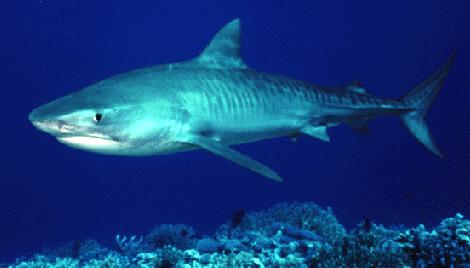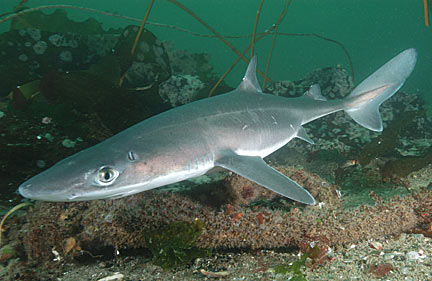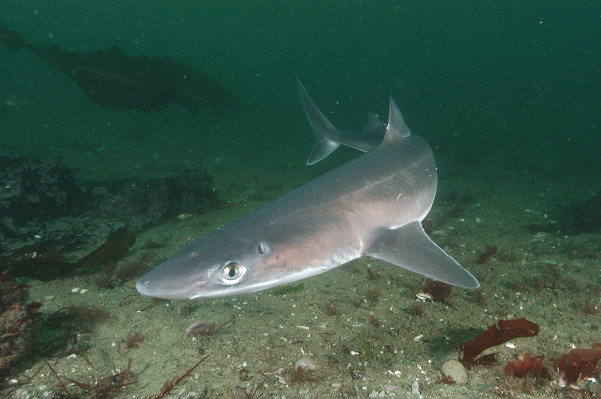
Tiger Shark

Tiger Shark

Tiger Shark

Tiger sharks (Galeocerdo cuvier) belong to the large-sized species of sharks. Their size is comparable to that of the white sharks (Carcharodon carcharias), but they look somewhat less massive. Although they have been proven to be involved in some accidents involving humans, they are still less well-known among the average population. This is due partly to the fact that science has not concerned itself so much with this species. Outside of Hawaii there are few projects specifically involving tiger sharks. This is somewhat surprising since the tiger shark is one of the largest and perhaps most common predator in the Bahamas, and the second most caught shark species in the Western Atlantic, the Gulf of Mexico and Cuba (see the special report "U.S. Government Shark Research Project" in this edition.) So a lot of mythologies revolve around tiger sharks, especially with members of the local island populations. They are one of the few shark species who not only change their body forms but also their skin pattern during growth. Another unique feature of tiger sharks are their astonishingly formed teeth, allowing them to rip apart almost any prey.
Biology of the tiger shark (Galeocerdo cuvier)
Appearance
The exterior appearance of a tiger shark is relatively atypical for the family of gray sharks (Carcharhinidae) for its body is longer and the snout is not pointed but noticeably flat and edgy. Tiger sharks are the only species of gray sharks with suction holes (Spiraculi). They were given the name because of the tiger-like pattern on their body during their youth, a pattern which slowly disappears with age and which eventually may only be faintly or no longer visible. This coloring probably serves as camouflage because the young usually stay close to the coast, directly below the water surface, and with their stripes they very much resemble the shadows of waves in the water.
Size and age
Tiger sharks usually grow to a length of 5.5 meters, however, assumably they may sometimes even grow to a size of more than 7 meters (Fourmanoir 1961). Their maximum age can only be estimated, but they can definitely reach a minimum age of 12 years. Adult tiger sharks do not really have any more enemies for their size prevents them from being chased by other shark species. Only the young are exposed to this kind of pressure.
Food
Tiger sharks are noted for having the widest food spectrum of all sharks. They can eat almost anything, from turtles to birds, as well as other sharks and fish. Besides normal prey they even eat garbage like tires, nails or car license plates, as sometimes documented by examinations of their stomach contents. For this reason they acquired the reputation of being "garbage eaters" and were considered primitive. In reality, it is exactly their diverse food palette and unique chewing mechanism which today puts them into a different light, for their apparent lack of specialization indicates a much higher development. Tiger sharks are special because they feed on a broad spectrum of prey rather than being specialized on specific prey. A shark species which can grow to a length of 5 meters thus has a selective advantage when its prey is not restricted (in the sense of their evolution). Sharks of this size need a lot of energy and any decrease in the numbers of one prey could well pose a threat to such highly specialized forms of life.
The chewing mechanism
The tiger shark's teeth and jaws is what differentiates this species from other gray sharks and generally from most other shark species. While the teeth of other sharks which hunt swimming prey as a rule are designed to cut in the upper jaw region and to grab and hold onto possible prey in the lower jaw, tiger sharks have rows of almost 24 identical teeth both in the upper and lower jaws. These teeth have both a cutting as well as sawing region. The flatter, rear tooth component protects the large saw from the tooth pressure which amounts to three tons per square centimeters (see photo).
Also in contrast to other sharks, their jaws have a square rather than round form. The jaw cartilage meets almost at a right angle in the middle of the snout, which gives this shark its typical appearance.
Reproduction
Pregnancy with tiger sharks lasts between 15 and 16 months. Normally, the young are born with a length of 50 to 70 centimeters, but depending on where they are born, the young may also be much larger. For example, in the region around Hawaii their size at birth reaches 80 to 90 centimeters. The average number of pups per litter is 41 (Crow, 1995), whereby the spectrum fluctuates between 10 all the way up to 80 (Compagno, 1984). Females appear to bear young only every three years. It is not known if males have a similar cycle, but generally they are presumed to have more of an annual cycle. Tiger sharks are the only species of gray shark who do not bear their young live with a placenta (placentally viviparous), but reproduce aplencentally viviparous. It is unclear if this should be considered a more primitive method of reproduction.
Distribution
Tiger sharks are found almost worldwide in tropical and moderate coastal regions, preferring murky waters and estuaries. In addition to these areas they are found near island groups such as the Marshall Islands, Hawaii, Tahiti or the Galapagos.
Behavior
Very little is known about the behavior of tiger sharks. They tend to be active at dusk or at night, demonstrating different behavioral patterns in various regions, depending on the time of day. Usually they stay in very flat regions in the evening and at night, preferring to retreat to lower depths during the day. Youngsters appear to be more active during the day than in the evening and demonstrate less hesitation to appear directly underneath the water surface. Although several animals may appear at the scene of food simultaneously, most larger animals tend to go their own way.
Encounters with humans
People who are not used to these animals should avoid them whenever possible. They are very curious and may be rather persistent when encountering skin divers who chase and harpoon fish. Even though the accident rate should not be overemphasized, it cannot be denied that most accidents in the tropics are ascribed to tiger sharks. Nevertheless, the danger of being bitten by a tiger shark is still relatively small - as is the case for all other shark species. In Hawaiian waters, a region frequented by numerous tiger sharks, the accident rate does not exceed one per year.
Mythology
It is somewhat astonishing that the old Hawaiians gave the same name to both the tiger shark and white shark: "Niuhi". Many shark species found in Hawaiian waters were honored as being sacred and were even considered reincarnations of dead family members. The "Niuhi" were, however, more feared than adored. Still, both species played a role in local mythology. Legends suggest that many kings living in the historical Hawaiian environment acquired their premonition of future events by consuming the eyes of the "Niuhi". It is said that even the mother of the most famous king of Hawaii, King Kamehameha (born around 1753 and having died on May 8, 1819) asked for "Niuhi" eyes during her pregnancy because they supposedly would enhance the leadership qualities of the future king she was carrying. Tiger sharks were always considered a very special shark species not only in the Pacific but also in the Maldives, where they were called "Femunu".












